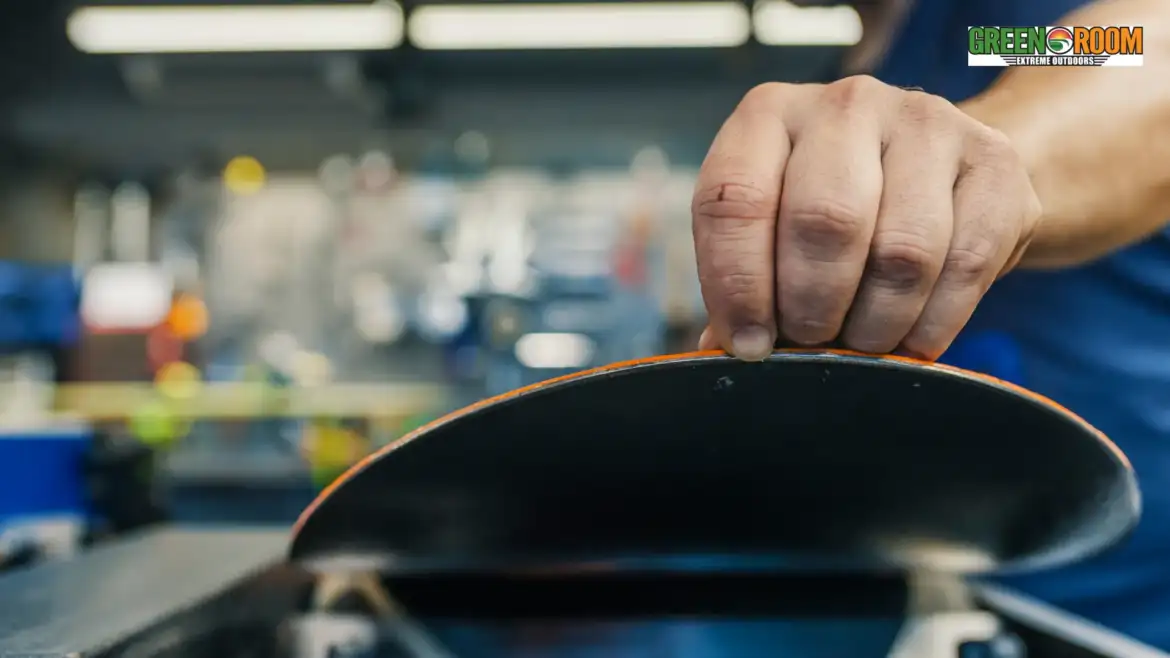Snowboarding is an exhilarating winter sport that requires proper gear maintenance to ensure a safe and enjoyable experience on the slopes. One crucial aspect of maintaining your snowboard is regular tuning, which can significantly impact your board’s performance and longevity.
In this comprehensive guide, we’ll dive into the importance of snowboard tuning and provide you with a step-by-step process for tuning your snowboard at home.
The Importance of Snowboard Tuning
Keep Your Board in Top Condition
Regular snowboard tuning is essential for keeping your board in top condition. Over time, the base of your snowboard can become scratched, gouged, or damaged, which can significantly impact its performance.
Additionally, the edges can become dull, reducing their ability to grip the snow effectively during turns and carves.
Improved Performance on the Slopes
A well-tuned snowboard glides smoothly over the snow, providing better control and responsiveness. Sharp edges allow for precise turns and carves, while a properly waxed base enhances speed and reduces friction.
By regularly tuning your snowboard, you’ll experience improved performance on the slopes, making your riding experience more enjoyable and efficient.
Essential Snowboard Tuning Equipment
Before you begin the tuning process, it’s crucial to gather the necessary equipment. Here’s a list of essential items you’ll need:
- Screwdriver: A screwdriver is required to remove or adjust various components of your snowboard, such as bindings or stance adjustments.
- Edge Sharpener: An edge sharpener is a tool designed specifically for sharpening and deburring the edges of your snowboard. There are various types available, including handheld and bench-mounted options.
- Nylon Brush: A nylon brush is used for cleaning the base of your snowboard and removing any debris or wax residue.
- Wax: Wax is an essential component of the tuning process, as it helps protect the base of your snowboard and enhances its glide. Different types of wax are available, including all-temperature wax and temperature-specific waxes.
- Iron: An iron is used to melt the wax and transfer it onto the base of your snowboard. Make sure to use a dedicated waxing iron or a household iron set to a low temperature to avoid damaging the base.
- Plastic Scraper: A plastic scraper is used to remove excess wax from the base of your snowboard after the waxing process.
- Sturdy Surface for Waxing: You’ll need a sturdy, flat surface to lay your snowboard on during the waxing process. A workbench or a table with a protective cover works well.
DIY Snowboard Tuning
When it comes to DIY snowboard tuning, having the right tools is essential. You’ll need a selection of snowboard tuning equipment such as a diamond stone, gummy stone, snowboard vise, and a clean towel. Tuning your snowboard helps maintain the base material and the base edge, which is crucial for a smooth ride. From tip to tail, tuning and waxing your board helps reduce drag caused by the edges. Shop REI’s selection of snowboard tuning tools for expert advice on the best way to protect and service your ski and snowboard.
One of the key moments in DIY snowboard tuning is setting the side edge and base edge at the correct edge angle. Using a drip wax and tune system, apply wax to the snowboard base and then scrape off the excess along the edge. This helps keep your ski or snowboard in top condition for your next ride. With REI’s selection of snowboard tuning equipment, you can easily learn how to properly tune a snowboard at home.
Base Repair and Edge Work
- Inspecting the Base for Damage: Begin by thoroughly inspecting the base of your snowboard for any scratches, gouges, or dents. Pay close attention to areas that may have sustained more significant damage, such as the nose and tail sections.
- Filling Scrapes with P-Tex: If you find any deep scratches or gouges, you’ll need to fill them with P-Tex, a polyethylene-based material designed for base repairs. Follow the instructions provided with the P-Tex product to properly melt and apply it to the damaged areas.
- Smoothing the Base: Once any repairs have been made, use a base grinder or a sandpaper block to smooth the entire base of your snowboard. This process will remove any remaining scratches or imperfections, creating a smooth surface for waxing.
- Removing Edge Burrs: Inspect the edges of your snowboard for any burrs or rough spots. Use the edge sharpener to carefully remove these imperfections, ensuring that the edges are smooth and even.
- Polishing Edges: After deburring, use the edge sharpener or a file to sharpen and polish the edges of your snowboard. A sharp, well-maintained edge is essential for maintaining grip and control on the slopes.
Waxing Your Snowboard
- Cleaning the Base: Before applying wax, use the nylon brush to thoroughly clean the base of your snowboard, removing any dirt, debris, or residual wax from previous applications.
- Applying Wax: Place your snowboard on a sturdy, flat surface and turn on the waxing iron to the recommended temperature. Once the iron is hot, apply the wax to the base of your snowboard in a smooth, even layer, covering the entire surface.
- Spreading the Wax: Use the hot iron to spread the wax evenly across the base of your snowboard, ensuring that it penetrates the porous material. Move the iron in a consistent pattern, applying pressure as needed.
- Scraping Off Excess Wax: Once the wax has cooled slightly, use the plastic scraper to remove any excess wax from the base of your snowboard. Hold the scraper at a shallow angle and apply firm, even pressure as you scrape the wax off.
- Finishing with Brushes: After scraping off the excess wax, use the nylon brush to further smooth and buff the base of your snowboard. This step will help ensure an even distribution of the wax and a smooth, glossy finish.
Tips for Successful Tuning
Here are some additional tips to help you achieve successful snowboard tuning:
- Work in a well-ventilated area, as the waxing process can produce fumes.
- Follow the manufacturer’s instructions for any tuning equipment or products you use.
- Be patient and take your time during each step of the process to ensure the best results.
- Consider investing in a tuning vise or clamp to securely hold your snowboard in place during the tuning process.
- Regularly sharpen your tools, such as the edge sharpener or scraper, to maintain their effectiveness.
Conclusion
Regularly tuning your snowboard is essential for maintaining its performance and longevity. By following this step-by-step guide, you can confidently tune your snowboard at home, saving money and ensuring that your gear is in top condition for every ride. Remember, proper maintenance not only enhances your riding experience but also contributes to your safety on the slopes. So, gather your tuning equipment, set aside some dedicated time, and give your snowboard the care it deserves for an unforgettable season on the mountain.




